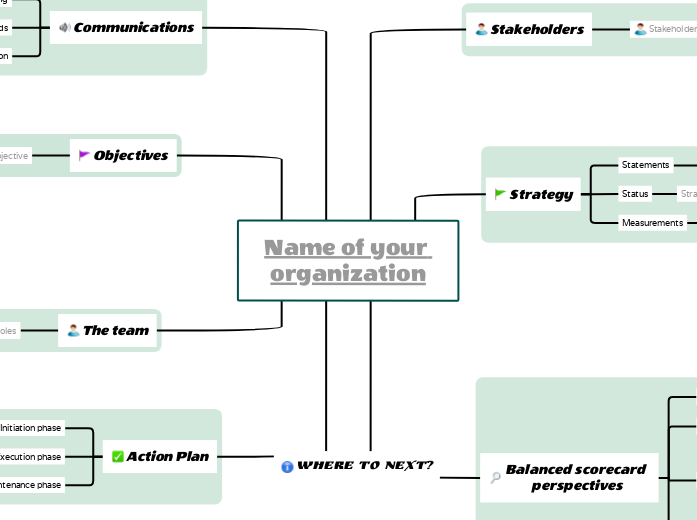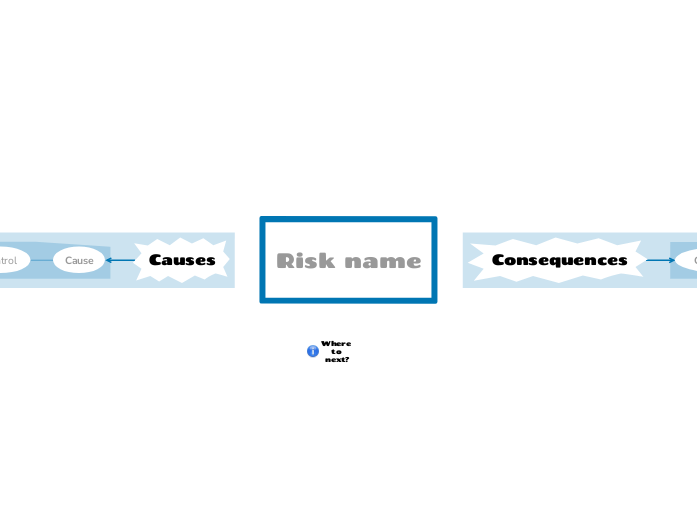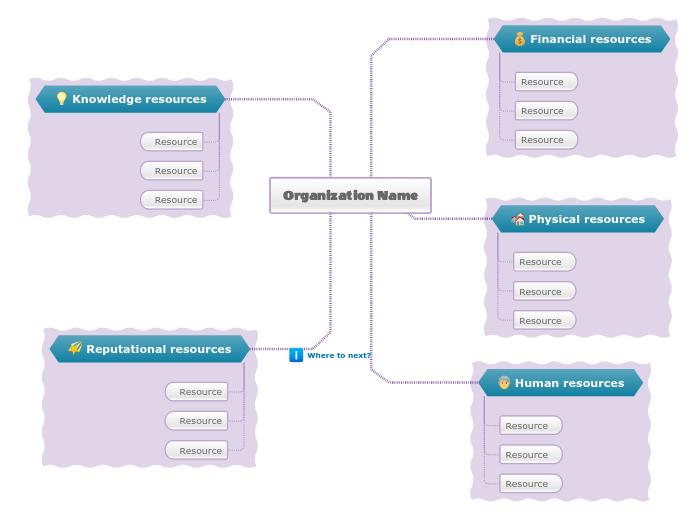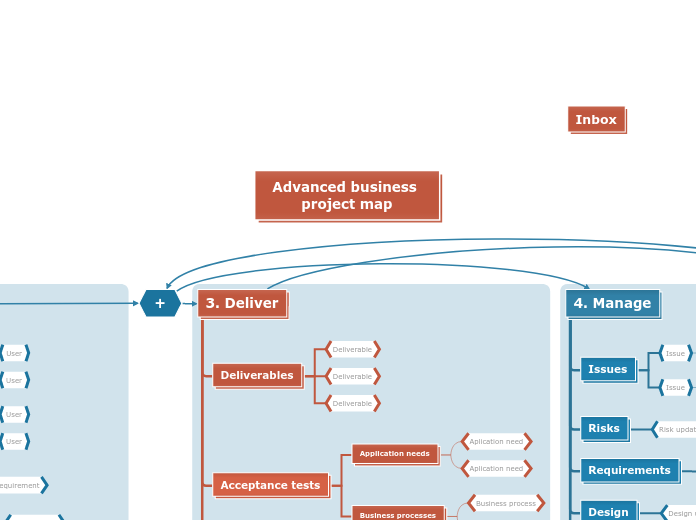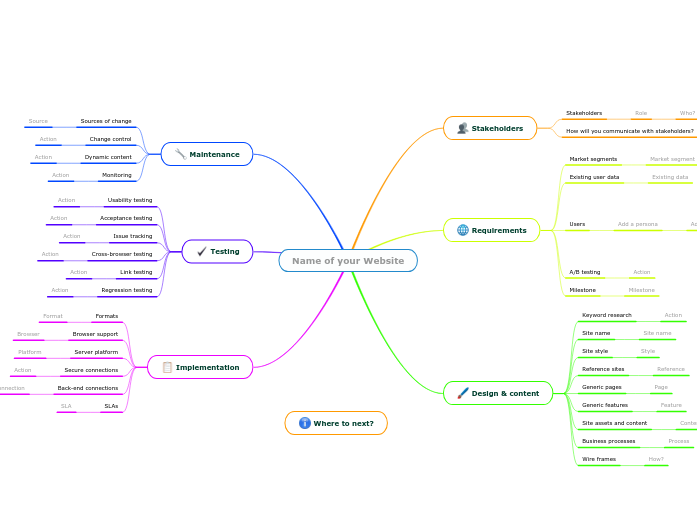Where to next?
Where next?
You can return to this map and re-use the Wizard as many times as you like.
Save the map as a normal Mindomo map and continue to work with it, using more of Mindomo's features.
Good luck with your project!
Name of your organization
Begin by entering your organisation's name in the central topic, then press Enter.
Action Plan
In this part of the map, plan out some initial actions for your Balanced Scorecard project.
Use this map to develop the plan further and keep track of actions as you make progress.
Maintenance phase
Add an action for the maintenance phase of your project, once the first round of improvement initiatives have been made. Think about:
- Regularly repeating measurements and reviewing trends
- Rewarding improvements
- Reviewing the effectiveness of the process
- Improving measurements for better results
- Realigning the programme with updates to objectives and strategy
- Maintaining communications and training
- Soliciting and acting on feedback
Execution phase
Add an action for the execution phase of your project. Think about:
- Identifying strategic measurements that reflect progress and potential for improvement
- Finalising a shortlist of a handful of measurements
- Designing measurements so that they have integrity and can be relied upon
- Agreeing measurements and targets with the people who will be affected by initiatives for change
- Creating a first set of benchmarks
- Communicating results for all to see
- Explaining what the measurements mean
- Working out what actions to take, and taking them
Initiation phase
Add an action for the initiation phase of your project. Think about:
- Getting corporate sponsorship
- Communicating and selling your project
- Forming a team
- Getting buy-in from those affected
- Identifying and helping those who may react negatively
- Resolving any lack of clarity over mission and strategy
- Communicating mission and strategy
Balanced scorecard perspectives
The four perspectives of the Balanced Scorecard technique help ensure that you are making measurements across all the important areas of your business.
Use the sections below to help identify further measurements, and to group any measurements that have already been identified by examining your stakeholder needs and strategy.
Learning and growth perspective
Motivation, empowerment and enlightenment
Add an employee motivation measurement that reflects the attitude of your staff and predicts future performance.
Measurements should be:
- Capable of consistent measurement
- Agreed to be more fact than opinion
- Can have a meaningful target value
- Capable of improvement
- Agreed as representative by the people taking action
Employee motivationEmployee satisfactionEmployee retentionImprovements achievedTeam performanceTargets reached & exceededStrategic awareness
Information systems capabilities
Add an information systems measurement that reflects the quality and accessibility of information available to your employees.
Measurements should be:
- Capable of consistent measurement
- Agreed to be more fact than opinion
- Can have a meaningful target value set
- Capable of improvement, by taking action
Accuracy of informationAvailability of informationTimeliness of informationAccessibility of informationCommunications efficiency
Employee capabilities
Add an employee capability measurement that reflects the skills, knowledge and performance of your employees, and predicts future capabilities.
Measurements should be:
- Capable of consistent measurement
- Agreed to be more fact than opinion
- Can have a meaningful target value set
- Capable of improvement, by taking action
- Not easy to manipulate to simulate success
Employee productivityStrategic skillsEmerging skillsSkills gapsSkills coverage ratioTraining levelsTraining initiatives
Internal business process perspective
Operations processes
Add an operations measurement that reflects the production performance.
Measurements should be:
- Capable of consistent measurement
- Agreed to be more fact than opinion
- Can have a meaningful target value set
- Capable of improvement, by taking action
- Not easy to manipulate to simulate success
ProcurementStock levelsQuality measuresLead timesThroughputsScrap ratesYield ratesDefect ratesWaste levelsOn-time deliveries
After-sales service processes
Add an after-sales service measurement that reflects the performance of customer support.
Measurements should be:
- Capable of consistent measurement
- Agreed to be more fact than opinion
- Can have a meaningful target value set
- Not easy to manipulate to simulate success
- Not a 'blame' factor that picks out individuals
ComplaintsSupport requestsSupport turnaroundReturnsRepairsRepair turnaroundService Level Agreements
Innovation processes
Add an innovation measurement that reflects innovation in your organization.
Measurements should be:
- Capable of consistent measurement
- Agreed to be more fact than opinion
- Can have a meaningful target value set
- Capable of improvement, by taking action
- Agreed as representative by the people taking action
Suggestions madeSuggestion adoptedSavings madeInnovation projects startedInnovation projects completedProduct launchesTime to marketTime to break-evenPatents and rights
External customer perspective
Add an external customer measurement that reflects future potential. Choose from the typical ones suggested, or preferably create your own.
Measurements should be:
- Capable of consistent measurement
- Agreed to be more fact than opinion
- Can have a meaningful target value set
- Capable of improvement, by taking action
- Agreed as representative by the people taking action
- Not easy to manipulate to simulate success
- Not a 'blame' factor that picks out individuals
Market shareCustomer acquisitionCustomer retentionCustomer satisfactionCustomer profitabilityProduct or service attributesCustomer relationshipsImage and reputation
Financial perspectives
Measurements in the Financial perspective show whether your company has performed well financially, where improvements can be made, and whether it is in a secure position.
Add a financial measurement that reflects achievement and progress.
The team
Support for your project is vital.
If your project is successful at identifying the need for significant change, then you can be sure there will be barriers to change and people to convince.
Key roles
Add a key player to your project. Think about:
- A project manager
- Corporate sponsors to influence and authorise change
- Buy-in from senior management
- Buy-in from team leaders who will need to implement change
- Buy-in from people already involved in other improvement initiatives
- Buy-in from anyone who is likely to resist focus on performance and change
- External expertise
Objectives
A Balanced Scorecard project will require resources and long-term commitment, and the results must be used to implement change, otherwise, it will die. In the same way that Balanced Scorecard is based on measurements, you should identify the KPIs for the project itself by agreeing on objectives and measuring progress towards them.
Project objective
Add an objective for your Balanced Scorecard project. Think about:
- Establishing an environment of management by measurement
- Identifying and correcting imbalances between internal/external factors and past/future indicators
- Identifying areas for improvement, taking action and evaluating results
- Identifying and reacting to trends
- Communicating strategy
- Aligning action with strategy
- Assessing whether strategy is being followed
- Assessing whether strategy is working
Communications
Continually communicating the results of your Balanced Scorecard project is vital.
Reviewing and taking action
Who will review the results, and what actions can they take?
Add an action for reviewing and applying the measurements.
Designing dashboards
What factors will influence the design of your dashboards, to keep people informed?
Add an action for designing your dashboards to communicate measurements and improvements.
Distributing and sharing
Action
How will the results of your project, and the background information that supports it, be distributed in your company?
Add an action for sharing the measurements from your project.
Strategy
Identify areas for measurement and management by thinking about your organization's mission, objectives and strategy.
Add a measurement against objectives or strategy. Measurements should be:
- Capable of consistent measurement
- Agreed to be more fact than opinion
- Can have a meaningful target value set
- Capable of improvement, by taking action
- Agreed as representative by the people taking action
- Not easy to manipulate to simulate success
- Not a 'blame' factor that picks out individuals
Status
Strategy status
Add comments about the status of your strategy today. Is it:
- Clearly defined and well communicated?
- Clearly defined, but not well known or understood?
- Defined, but known to be out of date?
- A bit informal or changeable?
- Not really defined at all?
- What action do you need to take?
Statements
Strategy statement
Add a statement about your mission, objectives or strategies.
If you are not clear on these, then consider using a VMOST analysis to create them.
Stakeholders
Stakeholder
In order to identify measurements that give insights into performance, be clear about the needs of all the stakeholders in your company.
Add a stakeholder who has an interest in the success of your organization.
You can choose from the suggestions, or better, add stakeholders that are specific to your company.
CustomersConsumersOwnersShareholdersStaffMembersRegulatorsThe communityPartnersSuppliers
Measurements
Measurement
Add a measurement that shows you understand stakeholder's needs and are meeting them.
- Where stakeholders have a choice, how well are you performing in comparison to your competitors?
- What measurements could you make that would show whether you are meeting their needs?
Needs
Add a stakeholder's need or requirement that plays a major role in your project.
- What are the needs of this stakeholder?
- How will they judge your performance?
- What does success look like to them?
- What will keep them engaged and supportive?
